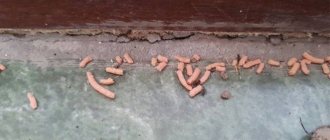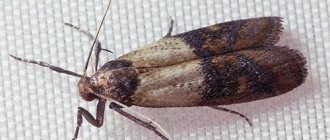The appearance of moles on the territory is an unpleasant surprise for any owner. Small diggers live in all regions of Russia and choose the best areas with soft, fertile soil for feeding. They are frequent guests on fertilized lands of summer cottages and lawns. Having discovered the characteristic cones of the earth, summer residents lose peace. Let's look at how to get rid of moles, which methods are the most effective and less expensive.
- How to get rid of moles depending on the place In the cellar Plants
- Blocking access
- Poisons
- Other methods
- Smell repellent
Plants to repel moles:
- An effective folk remedy for pest control is the bulb of the imperial hazel grouse plant. The aroma of this plant resembles the smell of fox skin. This is exactly what moles don’t like. Place the bulbs on the floor and in nooks and crannies of the cellar.
- Castor bean fruits also help in repelling animals. In order not to search for a plant for a long time, you can plant it on the site. Place the fruits collected in the fall on food stored in the cellar. This way they will remain untouched by moles.
As practice shows, repelling pests with aromas does not always guarantee a positive and long-lasting effect. Therefore, you should not place high hopes on these available means.
Plastic bottles from Andrey Berezin
Andrey Berezin used the most famous method of fighting moles - a homemade “noise maker”. To make it, take any plastic bottle and cut 3-5 “windows” on its side surface. Bend the cut plastic to one side. Now all that remains is to attach the noise repeller.
To do this, take a metal rod, and in the bottom of the bottle make a hole with a slightly larger diameter than the diameter of the rod (due to this size, the bottle will not be statically fixed, but will be able to “dangle” freely on the pole, which will create additional sounds). Fix the container on the rod and stick it next to the moles’ habitat. To be safe, make several of these pinwheels and place them every 10-15 m throughout the area.
The wind will create noise, the metal pin will transmit it to the ground. Moles don’t like such a noisy life, so they go to quieter neighbors. As soon as you notice the appearance of new individuals, repeat the procedure.
You can also use this version of the “noise maker”, as in the photo. In this case, the noise is created by rotating blades that are loosely attached to the neck of the bottle.
Poisons and poisons
If precautionary measures do not help, and it was not possible to scare off the moles. It is worth resorting to “heavy artillery”. But you need to be as careful as possible with store-bought insecticides. Do not forget that you are using them to treat the cellar where food is stored.
Arsenic or rat poison is suitable for exterminating moles. It needs to be mixed with bait and placed in plastic trays. Moles love to feast on meat or earthworms. You should not use cereal products as bait; pests are indifferent to them.
Stores also sell a special gel “Efa”, which is mixed with minced meat and spread over mole holes. Regarding poisonous gases, it is not recommended to smoke the cellar with them yourself. Some types of poisonous gas accumulate in the basement. It is better to entrust this matter to professional pest control experts.
Description of the pest
There are 6 species of moles living in the post-Soviet space:
• small mohera;
• large mogera;
• small;
• ordinary (European);
• blind.
Mole and his holes
The mammal is found in the taiga and forest-steppe, living in loose and fertile soils rich in earthworms and other underground insects. The most common species is the common mole. The size of an adult animal reaches 18 cm, weight 130 g. The mole is blind, but has excellent hearing and smell. It will not be possible to stroke him against the fur, since it grows perpendicular to the body. This feature allows the digger to move underground equally well in different directions.
An individual eats up to 60 g of food per day. Without food, the mole dies within 14-17 hours, so it is forced to constantly obtain food for itself.
In search of food, the animal digs up to 50 m of new tunnels per day, while regularly visiting the already dug tunnels. The animal’s favorite habitat is vegetable gardens and summer cottages, and there is a reason for this: the soil is regularly enriched with organic matter and loosened. Such an environment is beneficial for earthworms, and this is all the mole needs.
The animal makes preparations for future use. When there is an abundance of worms, he bites them and puts them in his storage. And although the mole is an insectivorous animal, it can make reserves from potatoes, carrots and other root vegetables, which greatly upsets gardeners.
Preparing supplies for the winter
Feeding passages run 2-5 cm from the ground surface, storage areas lie from 0.5 to 1 m, and the nest is located at a depth of 1.5 - 2 m under the roots of a tree or stump. Moles live up to 4-5 years; by nature they are solitary and come together only to procreate. The female breeds offspring once (rarely twice) a year in the spring. There are from 4 to 8 cubs in a litter. They grow quickly and after 1.5 months reach the size of an adult animal. Subsequently, the young individuals leave the nest and begin an independent life, moving away from the nest to a considerable distance (up to 2 km). Armed with knowledge about the characteristics of the animal, we will study how to get rid of moles in a summer cottage or garden once and for all.
How to store potatoes from rats. Stages of potato harvesting
Harvesting tubers consists of several stages:
- Digging potatoes;
- Drying tubers;
- Transportation (or transfer to the storage location);
- Bulkhead, sorting;
- Bookmark for storage.
The last stage can vary greatly. This depends on the gardener’s capabilities (availability of storage) and his preferences.
Some people have a cellar, others only have a balcony for storage.
You can store tubers in pits, and if there is a large quantity and space available, you can build trenches.
Digging up potatoes
It’s easier, of course, to dig potatoes mechanized: with a walk-behind tractor. But not everyone has such a mechanism.
And the areas under potatoes are generally small; you can handle them with a shovel or a pitchfork.
Therefore, we harvest potatoes using these two ancient, but relevant, methods.
What exactly is up to the grower to decide.
They try to grow potatoes on light soil; if this is the case, a pitchfork will do the job. Dense soil is too much for the forks; they may break or fail to turn out the bush properly.
In dense areas you will have to dig with a shovel.
Task: select all the potatoes, if possible, and preferably whole ones. It’s not 100% possible, but you have to strive.
Damage is inevitable: a shovel sometimes cuts a tuber, a fork sometimes punctures it.
That’s why it’s so important not to overexpose the harvest: while the tops are visible, it’s easier to navigate. Procedure:
Procedure:
- The bush is dug up with a shovel or pryed up with a pitchfork, and then the tubers are picked by hand. You can help yourself with a small garden trowel or a wire-toothed digger. “Comb” the holes with these teeth.
- Accidentally damaged potatoes are immediately sorted separately: the first to be used for food is unsuitable for storage.
- If it is dry, the tubers are laid out directly in the field to dry. But if there are pests, especially potato moths, the produce must be removed immediately. And away from the growing area.
- When the potatoes are healthy and free from pests, they can be stored separately as seeds. And don’t remove it as soon as it dries, remove the food from the field first.
- Green the seed a little: this way it will become more stable and will not get sick in storage. Or the waste will be minimal. Pests also do not like solanine, with the exception of the Colorado potato beetle. But the beetle is not present during storage; it prefers soil for wintering.
When carrying out greening, remember moderation. By exposing the tubers to the light and getting intensely green skin, you risk overdoing it.
The germination capacity of such tubers will decrease, and some may become non-germinating at all.
Only a slightly greenish color is acceptable.
Method number 4: natural predators
Everything is simple here. It is enough to get a cat, preferably a mongrel cat, that can catch mice. Usually they choose a pet that has or had excellent hunters in their family.
It is clear that if you have a cat and mouse trap, it is undesirable to use poison. Otherwise, it will be possible not only to get rid of harmful eared creatures for a while, but also to lose your beloved pet:
- he either accidentally eats the bait;
- or catch a poisoned mouse and through it receive a lethal dose of a poisonous substance.
In any case, during a chemical attack, it is better to close all domestic animals for a while and not allow them on the local safari.
Setting a trap
- They choose the place where the main tunnel is located in the system of passages dug by moles;
- They destroy the passage by tamping the soil with their feet, which will create an insurmountable barrier;
- If the tunnel is located quite deep, then you can reach it with a shovel, placing a lump of earth on the bottom, leaving the passage free;
- The grips of the scissor trap are placed on both sides of the lump, leaving a passage; fastening occurs according to the instructions;
- The trap is placed in the tunnel so that the mole can easily penetrate inside, and if the trap is made at home, then the recess is covered with a board on top;
- A harpoon-type trap is placed across the entire width of the tunnel, pressing the posts into the soil. The trigger must be above the hole. The handle is tightened and the mechanism is brought into full readiness;
- The installation of the structure must be carried out taking into account its type and the expected result; after installation, it is necessary to observe it for some time, check whether a mole has been caught;
- If not a single individual is caught in 2 days, you need to move the trap to another place;
- If an animal dies after falling into a trap, it must be taken as far as possible from water sources or pipelines and buried. If the animal is still alive, it must be removed from the trap. In this case, you can get rid of it in the forest or field, and also hand it over to zoologists.
Getting rid of moles in a timely manner means protecting the crop from destruction. If you don’t want to deal with such control yourself, you can call a specialized organization whose team will quickly and efficiently get rid of pests.
Electronic repellent devices
In their garden plots, owners often use electronic repellent devices. This frees people from having to dig up the ground in search of molehills, as well as from clogging the soil with chemicals. This method captivates summer residents with its simplicity and convenience.
Such electronic devices should be buried to the depth specified in the instructions and dead batteries should be replaced from time to time. When the device is turned on, it makes sounds that are unpleasant for moles or creates vibration.
A person does not feel such vibrations, but they cause great discomfort to a mole. Tireless diggers will be forced to leave their favorite area and seek their fortune elsewhere.
The following models are considered the best electronic repellers today:
- Space. The device simultaneously produces unpleasant sounds and vibrations. Some models are available with solar power.
- Tornado. Such repellers can be sold as vibration or sound-vibrating ones. One device is enough for a plot of 15 acres. Powered by 4 batteries. The price of the device can reach up to 2.5 thousand rubles.
- Typhoon Anti-Crote. This ultrasonic repeller comes with a buzzer.
- Yochomi. The device was developed in Japan and manufactured in Taiwan. The device is very reliable in operation and has been operating for several decades.
- EcoSniper. A similar brand is produced in Russia; it effectively repels snakes and moles from the area.
- Scat. Ultrasonic device. For a plot of 10 acres, one device of this type is sufficient.
- Remling series of devices. The devices of this company are different. They can make a sound that is unpleasant to moles, create vibration or emit ultrasonic waves.
Important! When purchasing ultrasonic repellers, you need to take into account the area of action and pay attention to what power source the device operates from. Sophisticated people recommend buying either a domestic device or a European-made product.
If there is a need to operate such devices in winter, then you need to choose repellers that are quite effective in frosty weather and frozen soil layers.
What is the harm from rodents in the basement and cellar?
Rats and mice that take up residence in a basement or cellar cause significant damage. They not only spoil supplies: they eat and nibble on potatoes and vegetables. Rodents can damage communications, wooden and even concrete structures, and chew and damage containers. In addition, in warmth and with plenty of food, they begin to actively build nests and reproduce.
A person faces great danger from such a neighborhood. Because rats and mice can be carriers of dangerous diseases, such as tularemia. Therefore, all measures must be taken to prevent dangerous parasites from accessing supplies. And if they do appear, then get rid of rodents as effectively as possible.
Humane methods of control
Wherever we meet a rat, it does not bring positive emotions.
The first factor of disgust is their appearance, especially the hairless long tail. Plus, all the facts related to epidemics caused by these rodents come to mind. And only then does a person realize the possible damage that this small animal will cause. Rats living in garages not only spoil the mood and frighten the owners with their presence, but also scatter things, damage property, and what’s most offensive is that when you get into your vehicle in the morning, you can find that the car does not want to start. And the reason for this is the wires that the uninvited guest tasted at night. Especially cases of such visits become more frequent with the arrival of cold weather, as the rat comes to bask under the hood.
The first thing you need to do is analyze where the guest came from, and whether it is possible to isolate your garage from a nearby landfill, farm, or production. It’s even possible that the only way to get rid of such a habit forever will be to sanitize not the garage, but the rodent’s permanent habitat.
Having ruled out this possibility, the best way to start fighting the rodent is to completely clean the garage and isolate it from the inside. Since in most cases the animal will not come if there is no food, you need to completely eliminate the presence of tasty foods in the room.
Then carefully examine the nooks and crannies to identify entry routes. If any are found, you need to arm yourself with a trowel, cement mortar and broken glass, and cover up the holes. This might stop the rats from visiting for a while. But over time, they will gnaw holes again, and the procedure will have to be repeated.
If the owner of the garage is characterized by pity and love for all living things, it would be best to use special traps. They have the shape of a rectangular box in which the bait is placed. When such a trap is triggered, the door closes and the rat falls into the trap without being harmed at all. All that remains is to figure out what to do next with the caught rodent.
There are even facts when a person tried to negotiate with rats, equating the intelligence of a mammal with his own. There have even been cases of positive results when the animal stopped coming and ruining a person’s life. Although there is no scientific confirmation of this. And if there is such a desire, no one will judge the one who wants to try to explain to the gray one in his spare time who is the boss in the garage.
As you know, rats do not like the smell of burnt fur. Taking advantage of this feature, you need to take a small amount of natural wool, set it on fire inside the garage and leave it in places where rodents migrate. It is possible that the smell will scare them away.
There are often cases when the owner of the garage and the rat live side by side, without interfering with each other at all. The person specifically leaves food for the little inhabitant, who, in turn, does not cause material damage to the hospitable host. You also need to remember that the rat will not allow strangers into its inhabited territory if food is not abundant. Therefore, in such cases, you should not wait for the invasion of guests.
Prevention on site
It often happens that somewhere not far from the site there are mounds dug up by moles. There are no such earthen piles on the site itself, but work is planned to improve the fertility of the land - a compost heap or manure pit is being prepared, mulching with a thick layer of freshly cut grass is being planned. In this case, you can be sure that blind diggers will come to hunt for worms, which will certainly appear under heaps of organic fertilizer.
There is only one way to protect yourself from their invasion, where there are no underground passages yet: to fence the perimeter of the site with a protective barrier that will either scare away or prevent them from digging a tunnel.
The most reliable barrier is considered to be one made of fine-mesh thick plastic or metal mesh, sheets of slate, roofing felt, or linoleum. All materials must be durable, able to withstand the powerful claws of the mole's front paws. You will have to dig the selected material to a depth of at least 50 cm. In this case, the upper edge of the fence should protrude 40 cm above the ground. Although it is believed that moles do not walk on the ground, it is known for sure that these animals can come to the surface and move over short distances.
What are moles afraid of?
When searching for food, these insectivores rely on information they receive through their sense of smell and hearing. They do not like strong odors, such as the stench of rotten fish, the smell of valerian, the stench of various chemicals such as white alcohol or carbide. Loud noise and vibration of the soil are also sources of anxiety for moles.
What plants can scare away
Plants whose roots emit a sharp, spicy odor—garlic, onions, daffodils, marigolds, castor beans—can scare off moles. Animals do not climb into a flower bed where hazel grouse grow along the edges, many sources on the Internet write about this. But it should be borne in mind that this barrier will be temporary, as long as plants with an odor difficult for moles are in the ground. At the same time, some individuals know how to deal with unpleasantly smelling plants: they simply push them out of the ground or go around a little deeper than the roots of the plant go down.
What harm is done to the garden?
When moving into a new area, a mole sets up its main home under the roots of trees. From here the beast builds two main tunnels. Feeding roads break out from the central roads in all directions, ending in holes leading to the surface. Exits to the surface also work as devices for ventilation of underground pipelines.
Most passages are located at a depth of 20-30 cm, that is, in the layer of earth where the roots of vegetables, flowers, and shrubs penetrate. By undermining the soil, the animal leaves the plant without food. Throwing soil to the surface while digging exits, making shallow roads that leave twisting, bulging ridges, moles turn land into a kind of dug up landfills. Lawns and flower beds look especially unsightly when there are dried or fresh piles of earth next to dead flowers.
Reasons for appearing on the site
Moles eat a lot and often; if they stop doing this, they can die within 24 hours. They most often live alone, but can also live in family groups, so several hundred meters of underground roads can be laid under a garden plot or vegetable garden in just a few days. Molehills are located not only parallel to the plane of the earth. The mole's lair, in which the female gives birth to her cubs, is usually located at a depth of 1.5 m to 2 m.
Moles will not be able to live where they cannot provide themselves with food and water. In garden plots where organic farming is practiced, there is always an abundance of earthworms - the main food of moles. After all, cultivated garden and garden plants are regularly fertilized and watered, that is, people provide the necessary conditions for soil fertility and nesting of worms. Behind the worms, moles appear on the site. Nearby streams or other sources of water are the second reason for populating a fertile vegetable garden.











